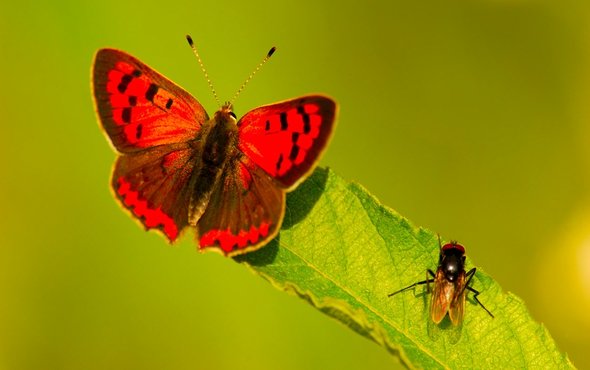(单词翻译:单击)
听力文本
This is Scientific American — 60-Second Science. I'm Jason G. Goldman.
Most critters seem better able to survive big cities if they're smaller than usual. But a few others are better adapted to urban areas if they're larger. That's the result of a study of more than 700 types of invertebrates from across 10 different taxonomic groups living in a variety of habitats in northern Belgium.
European ecologists were interested in understanding how animals adapt to urbanization. So they set up a variety of traps in both urban and rural areas, and assessed the body size of more than 95,000 individual critters.
They measured butterflies, beetles, weevils, ground spiders, web-building spiders, moths and grasshoppers. They also tested a handful of more obscure invertebrates, like a group of microscopic shrimplike critters called ostracods, and a group of aquatic crustaceans known as water fleas.
On average, urban communities contained smaller individuals than rural ones. It's not that cities are causing animals to evolve smaller bodies, at least not necessarily. What this study found is that animals that are already smaller seem better suited to city living. The researchers think that has to do with what's called the urban heat island effect. Animals expend more energy going about their daily lives in warmer areas, and cities tend to be warmer than more natural areas. Smaller body sizes can compensate for that heat effect.

But some groups of city dwellers were actually bigger than were their countryside counterparts.
"For three of our groups, for butterflies, moths, and for grasshoppers, we actually saw a completely reversed pattern...these three groups, out of the 10 groups that we tested, these were the only groups where large species are also the most mobile ones."
Catholic University of Louvain ecologist Thomas Merckx.
These are animals that need wide spaces, something that's in short supply in cities, where roads and housing developments easily fragment natural habitats. Being bigger helps them move from one habitat patch to another more easily than their diminutive relatives. The results are in the journal Nature.
"As humans, we have become urban animals. So this is our new habitat. It wasn't the case a hundred years ago. Only a tiny minority of the human population was living in cities. But urbanization really is taking off. So now more than half of humans are already living in cities, and this is only going to increase."
And humans are part of a wildlife community, even in cities. We need lots of other animals, including ones we might not always think about, like moths and spiders, to thrive in cities as well. Understanding how animals are adapting—or not—to urban areas today can help us build better, more wildlife-friendly cities in the future.
Thanks for listening for Scientific American — 60-Second Science. I'm Jason G. Goldman.
参考译文
这里是科学美国人——60秒科学。我是杰森·古德曼。
对大多数生物来说,如果它们的体型比常规小,那它们则能更好地在大城市生存。但其他少数生物,则是体型越大越能更好地适应城市生活。这一结论来自一项涵盖700多种无脊椎动物的研究,该研究将比利时北部地区各种栖息地的无脊椎动物分成10个不同的分类组。
欧洲生态学家对动物如何适应城市化的方式很感兴趣。因此,他们在城市和农村设置了各种各样的捕捉器,并测量了超过95000只个体生物的体型。
他们测量了蝴蝶、甲壳虫、象鼻虫、地蜘蛛、织网蜘蛛、飞蛾和蚱蜢的体型。他们还测试了少量不太知名的无脊椎动物,比如一组微小的虾状介形亚纲动物,以及一组被称为水蚤的水生甲壳类动物。
平均而言,城市生物群内的个体体型比乡村要小。城市并不是导致动物进化成更小个体的原因,至少不一定是。这项研究发现,体型已较小的动物似乎更适应城市生活。研究人员认为这与“城市热岛效应”有关。在较温暖地区,动物在日常生活中会消耗更多能量,而城市往往比自然地区的温度要高。较小的体型能弥补这种热效应。
但在有些分类组中,在城市生活的动物实际上比在乡村生活的体型要大。
“在蝴蝶、飞蛾和蚱蜢这3个组中,我们确实看到了完全颠倒的模式,在我们测试的10个组中,只有这3个组既是大型物种也是最具流动性的物种。”
鲁汶天主教大学的生态学家托马斯·麦克斯说到。
这些是需要广阔空间的动物,而有时城市缺乏广阔空间,城市的道路和住宅区很容易割裂自然栖息地。体型较大的动物在栖息地斑块之间迁移时,比其体型小的亲戚要容易得多。这项研究结果发表在《自然》期刊上。
“作为人类,我们已经成为了城市生物。可以说,城市是我们的新栖息地。而100年前并不是这样。当时只有极少数人居住在城市。但是城市化的进程非常快。现在人类已有超过一半的人口生活在城市中,而且这一数字只会继续增加。”
人类是野生动物的一部分,即便在城市中也是如此。我们也需要大量的其他动物,包括那些我们可能并不经常想到的动物,比如飞蛾和蜘蛛,我们需要它们在城市里繁衍兴盛。了解动物适应或不适应今天的城市地区,有助于我们未来建设更好、对野生动物更友好的城市。
谢谢大家收听科学美国人——60秒科学。我是杰森·古德曼。
译文为可可英语翻译,未经授权请勿转载!
重点讲解
重点讲解:
1. adapt to 适应;
The astronauts are conducting a series of experiments to learn more about how the body adapts to weightlessness.
那些宇航员正在进行一系列实验,以更多地了解身体如何适应失重状态。
2. go about 从事,进行(日常的活动);
Despite the threat of war, people went about their business as usual.
虽然战争在即,人们照常忙着自己的事。
3. compensate for 弥补;补偿;
The company agreed to keep up high levels of output in order to compensate for supplies lost.
这家公司同意保持高产量以弥补供货丢失带来的缺口。
4. take off (产品、活动、事业等)腾飞,突然成功;
In 1944, he met Edith Piaf, and his career took off.
1944年,他结识了伊迪思·比阿夫,从此他的事业开始腾飞。


